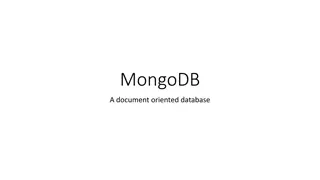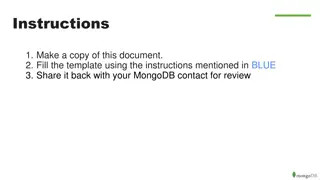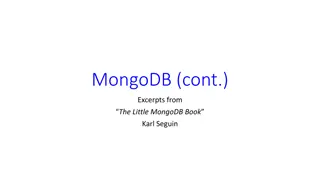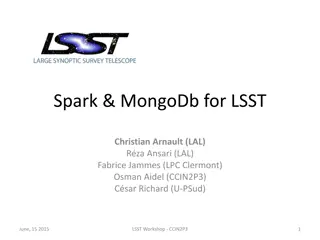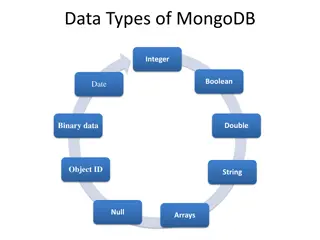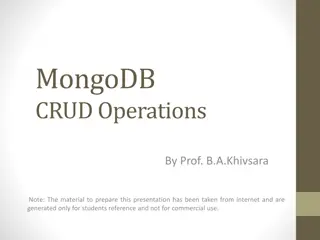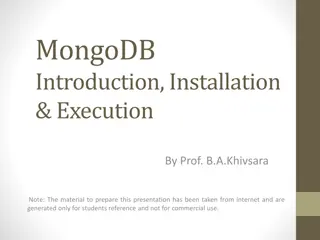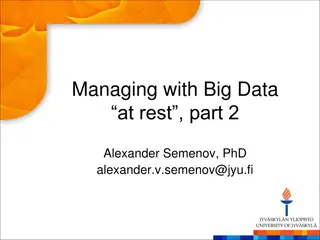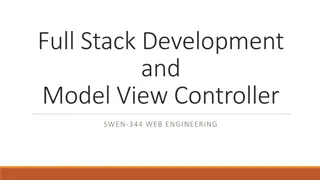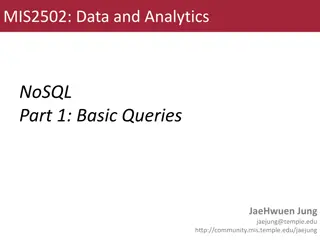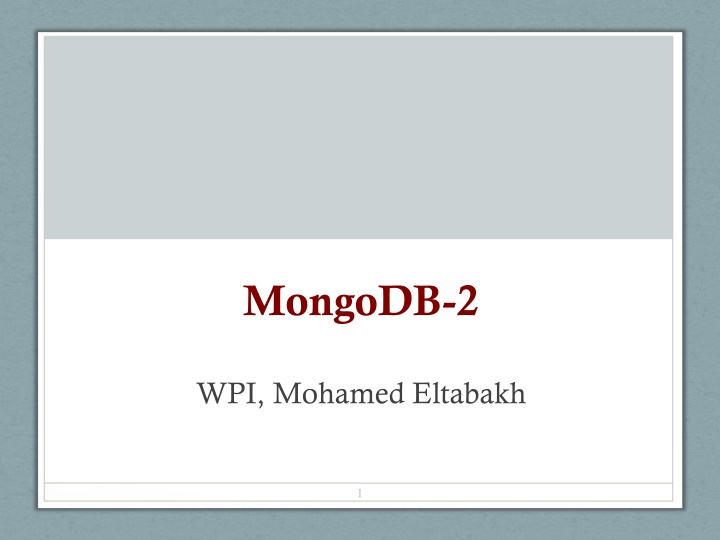
Efficient Querying in MongoDB: Mastering the Query Language
Learn how to efficiently query in MongoDB using the powerful query language. Discover the various operators, projections, exclusions, and advanced querying techniques. Understand cursor manipulation and querying complex types to enhance your MongoDB skills.
Download Presentation

Please find below an Image/Link to download the presentation.
The content on the website is provided AS IS for your information and personal use only. It may not be sold, licensed, or shared on other websites without obtaining consent from the author. If you encounter any issues during the download, it is possible that the publisher has removed the file from their server.
You are allowed to download the files provided on this website for personal or commercial use, subject to the condition that they are used lawfully. All files are the property of their respective owners.
The content on the website is provided AS IS for your information and personal use only. It may not be sold, licensed, or shared on other websites without obtaining consent from the author.
E N D
Presentation Transcript
MongoDB-2 WPI, Mohamed Eltabakh 1
Query Language in MongoDB 2
Find() Operator Means ascending 3
Find() + Projection Means inclusion + _id is always automatically included Equivalent to in SQL: 4
Find(): Exclude Fields Means exclusion Means equality Cannot mix inclusion & exclusion in the same operator except for _id 5
Find() More Examples Report all documents in the inventory collection db.inventory.find( ) Select * From inventory; Equivalent to in SQL: db.inventory.find( {} ) Report all documents in the inventory collection Where type = food or snacks Select * From inventory Where type in ( food , snacks ); Equivalent to in SQL: db.inventory.find( { type: { $in: [ 'food', 'snacks' ] } } ) 6
Find(): AND & OR AND Semantics OR Semantics AND + OR Semantics Type = food and (qty > 100 or price < 9.95) 7
$AND True True True False False Any thing is true except 0 (for numbers), Null (for objects). Arrays evaluate to True 8
Queries Return Cursors All queries return a the results in a cursor If not assigned to a variable Printed to screen Results are stored in a cursor Many operators on top of that to manipulate the cursor Cursor s Methods: http://docs.mongodb.org/manual/reference/method/js-cursor/ 9
Cursor Manipulation Dumps the content to screen (1st 20 document) Explicitly iterate over each document Shortcuts for iterations 10
Querying Complex Types Documents can be complex, E.g., (Arrays, embedded documents, any nesting of these, many levels) Queries get complex too !!! 12
Array Manipulation (Exact Match) 13
Array Manipulation (Search By Element) Notice: if a document has ratings as an Integer field = 5, it will be returned 14
Array Manipulation (Search By Position) Notice: if a document has ratings as an Integer field = 5, it will not be returned 15
Array Manipulation ($elemMatch) 16
Embedded Object Matching (Exact doc Matching) Exact-match (entire object) // match 18
Embedded Object Matching (Field Matching) Using dot notation db.persons.find( { address.state : CA }) 19
Try This 20
Matching Arrays of Embedded Documents Select all documents where the memos array contains in the 1st element a document written by 'shipping department 21
Matching Arrays of Embedded Documents db.inventory.find( { 'memos.0.by': 'shipping' } ) // Returns 1st document Means the 1st element in the array 22
Matching Arrays of Embedded Documents Select all documents where the memos array contains a document written by 'shipping department 23
Matching Arrays of Embedded Documents db.inventory.find( { 'memos.by': 'shipping' } ) // Returns both documents Means any element in the array 24
Matching Arrays of Embedded Documents: Multiple Conditions Select all documents where the memos array contains a document written by 'shipping department and the content on time 25
Matching Arrays of Embedded Documents: Multiple Conditions 26
Query Operators http://docs.mongodb.org/manual/reference/operator/query/ Comparison Operators Logical Operators Element Operators Evaluation Operators Array Operators 27
Query Operators: Comparison Op db.inventory.find( { qty: { $gte: 20 } } ) db.inventory.update( { "carrier.fee": { $gte: 2 } }, { $set: { price: 9.99 } } ) 28
$Where Operator Passes a JavaScript expression or function to the query system Very flexible in expressing complex conditions But it is relatively slow as it evaluates for each document (no indexes) Similar to using UDF in the Where clause in relational databases ); 30
$Where Operator Can combine MongoDB operators with $Where db.myCollection.find( { active: true, $where: "this.credits - this.debits < 0" } ); db.myCollection.find( { active: true, $where: function() { return obj.credits - obj.debits < 0; } } ); Is this And semantics or Or semantics ??? 31
Collection Modeling Modeling multiple collections that reference each other In Relational DBs FK-PK Relationships In MongoDB, two options Referencing Embedding 33
FK-PK in Relational DBs Create Students relation Create Courses relation l l CREATE TABLE Students (sid CHAR(20), name CHAR(20), login CHAR(10), age INTEGER, gpa REAL); CREATE TABLE Courses (cid Varchar2(20), name varchar2(50), maxCredits integer, graduateFlag char(1)); Foreign key Foreign key Create Enrolled relation l CREATE TABLE Enrolled (sid CHAR(20), cid Varchar2(20), enrollDate date, grade CHAR(2)); Each tuple in Enrolled reference a specific student and a specific course 34
In MongoDB Referencing between two collections Use Id of one and put in the other Very similar to FK-PK in Relational DBs Does not come with enforcement mechanism Embedding between two collections Put the document from one collection inside the other one 37
Referencing Have three collections in the DB: User , Contact , Access Link them by _id (or any other field(s)) 38
Embedding Have one collection in DB: User The others are embedded inside each user s document 39
Examples (1) Patron & Addresses If it is 1-1 relationship If most of these hold better use Embedding If usually read the address with the name If address document usually does not expand 40
Examples (2) Patron & Addresses When you read, you get the entire document at once In Referencing Need to issue multiple queries 41
Examples (3) What if a Patron can have many Addresses Do you read them together Go for Embedding Are addresses dynamic (e.g., add new ones frequently) Go for Referencing 42
Examples (4) What if a Patron can have many Addresses Use array of addresses 43
Examples (5) If addresses are added frequently This array will expand frequently Size of Patron document increases frequently May trigger re-locating the document each time (Bad) 44
Document Size and Storage Each document needs to be contiguous on disk If doc size increases Document location must change If doc location changes Indexes must be updates leads to more expensive updates In a newer version, each document is allocated a power-of-2 bytes (the smallest above its size) Meaning, the system keeps some space empty for possible expansion 45
Examples (6) One-to-Many Book , Publisher A book has one publisher A publisher publishes many books If embed Publisher inside Book Repeating publisher info inside each of its books Very hard to update publisher s info If embed Book inside Publisher Book becomes an array (many) Frequently update and increases in size 46

